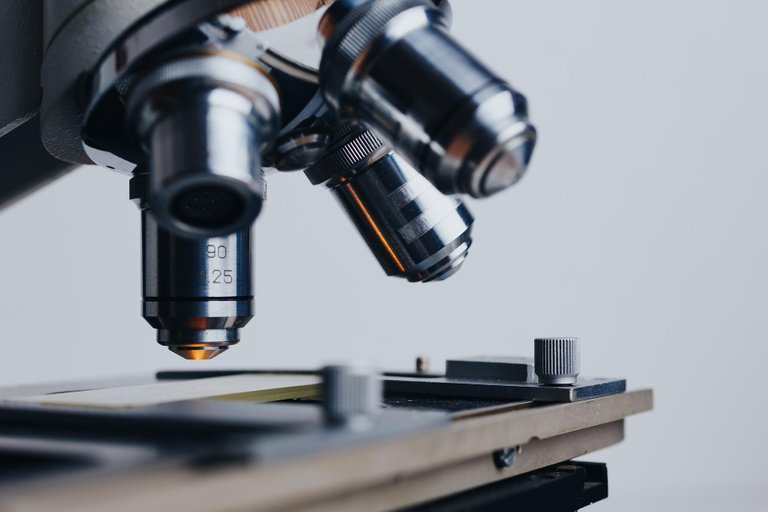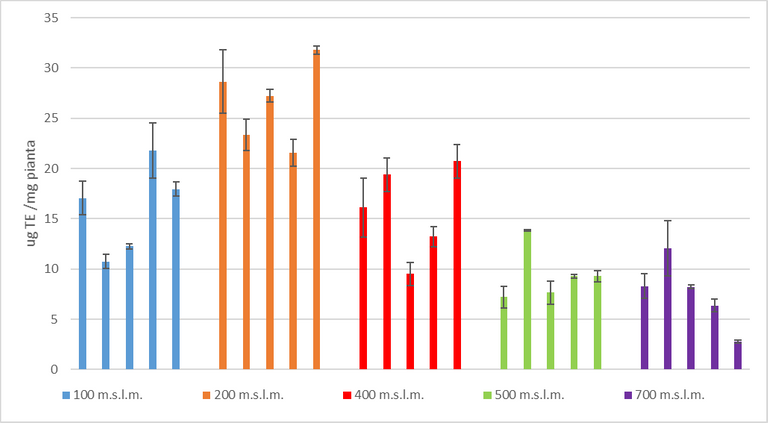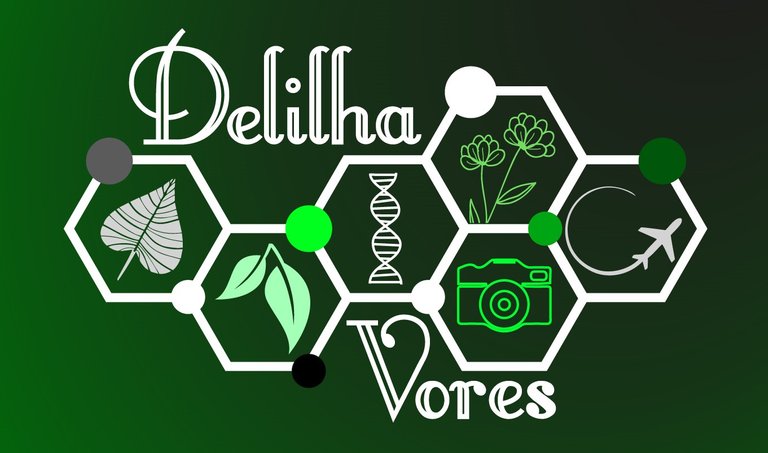Hello everyone!
Today I take you with me to a laboratory day where I analyzed several samples of Dactylis glomerata in order to determine its antioxidant power. Samples of this botanical species were collected on the Stromboli volcano (Sicily, Italy) at different altitudes, and the aim is to study whether this aspect could have an influence on the amount of antioxidants produced by the plant. Let's start!
Description of the botanical species
The dactyl (Dactylis glomerata L.) is a herbaceous species of the Poaceae family widely cultivated as a fodder plant.
Its name derives from the Greek "δακτυλοϛ" "dáctylos", that is finger, due to the similarity of the cob with the phalanges of a finger and from "glŏmĕro", that is to wrap, curl up, thicken, group with parts joined together in a bunch at the apex, like the flowers grouped in an inflorescence.
It is a rustic plant, resistant to cold, drought and with great adaptability to all types of soil.
Characterized by large productive yields, 100-120 quintals per year per hectare, it can use the land for many years as it is perennial and very long-lived.
The dactyl is a mowing (early earing) or grazing plant. With mowing it is mainly used as hay and is also an important component of oligophytic meadows. It is generally grown together with alfalfa.

Public domain photo from https://it.wikipedia.org/wiki/Dactylis_glomerata
Antioxidant power
As previously mentioned, the aim of this study was to evaluate the antioxidant power of the Dactylis glomerata plant. But what exactly is meant by "antioxidant"?
From a chemical point of view, the term antioxidant means a substance capable of counteracting, slowing down or neutralizing the formation of oxygen radicals that are formed as a result of oxidation reactions.
This type of reactions take place continuously in the body and lead to the formation of highly reactive intermediate products, known as oxygen free radicals or ROS, capable of causing damage to various molecules and cellular structures, first of all DNA, but also proteins. and lipids that make up cell membranes.
The body naturally produces a series of endogenous antioxidants, such as glutathione, coenzyme Q and superoxide dismutase and catalase enzymes. Many other antioxidants are introduced into the body daily through food. Hence the importance of a healthy and balanced diet!
When the production of free radicals is excessive, or the reserve of antioxidants is insufficient, a condition of oxidative stress can arise and this condition can lead to the onset of certain diseases such as:
- Neurodegenerative diseases (such as Parkinson's disease, Alzheimer's, amyotrophic lateral sclerosis, ...);
- Diseases of the cardiovascular system (such as atherosclerosis, ...).
Antioxidant assay
The method used today to determine the quantity of antioxidants is based on a colorimetric reaction, that is a spectrophotometric analysis that exploits the property of many organic and inorganic substances to give, for themselves or through suitable transformations, colored solutions in which the intensity of the color is a function of the concentration of the dissolved substance. In particular, 1,1-diphenyl-2-picrylhydrazyl (DPPH) in a methanolic solution has a purple color and has a maximum absorption at a wavelength of 517 nm.
The antioxidant assay to detect DPPH was performed using the VICTOR X3 Perkin Elmer microplate reader, while the in vitro antioxidant power was determined using the Trolox to perform the calibration curve. Trolox is an analogue of vitamin E soluble in water and has an antioxidant power equal to this vitamin. In fact, we need it to be able to compare the antioxidant power of our real samples to a literature reference.
The results were calculated as a percentage of discoloration compared to the control using the following formula which analyzes the absorption:
% Discoloration = [(Abs negative control - Abs sample) / Abs negative control] x 100
The antioxidant capacity of the extracts was calculated by expressing it in µg of TE (trolox equivalent) per mg of plant (dry weight).

Photo by Konstantin Kolosov from Pixabay
Results
With this method, numerous samples have been analyzed and what has been observed is that above 400 meters the plant has a lower antioxidant power. The cause is probably that, despite the very fertile soil at those altitudes, the synthesis of substances is very low at the expense of the production of other metabolites more useful for the survival of the plant at higher altitudes.
This type of research is performed in many laboratories that study medicinal plants. In fact, it is always hoped to find some interesting data relating to the antioxidant properties of some botanical species that could lead to the formulation of totally natural and useful active ingredients for our health.

I hope this post was interesting for you. For doubts or clarifications do not hesitate to write below, see you next time!
Delilha

ITA
Ciao a tutti!
Oggi vi porto con me in una giornata di laboratorio dove ho analizzato diversi campioni di Dactylis glomerata al fine di determinarne il potere antiossidante. I campioni di questa specie botanica sono stati raccolti sul vulcano Stromboli (Sicilia) a diverse altitudini, e lo scopo è studiare se questo aspetto potrebbe avere un’influenza sulla quantità di antiossidanti prodotti dalla pianta. Iniziamo!
Descrizione della specie botanica
La dattile (Dactylis glomerata L.), chiamata anche erba mazzolina, è una specie erbacea della famiglia delle Poaceae ampiamente coltivata come pianta da foraggio.
Il suo nome deriva dal greco “δακτυλοϛ” “dáctylos”, ovvero dito, per la somiglianza della pannocchia con le falangi di un dito e da “glŏmĕro”, ovvero avvolgere, raggomitolare, addensare, raggruppare con parti riunite a mazzo all'apice, come i fiori raggruppati in un’infiorescenza.
Si tratta di una pianta rustica, resistente al freddo, alla siccità e dotata di una grande adattabilità a tutti i tipi di terreno.
Caratterizzata da grandi rese produttive, 100-120 quintali annui per ettaro, essa può impiegare il terreno anche per molti anni essendo perenne e molto longeva.
La dattile è una pianta da sfalcio (a inizio spigatura) o da pascolo. Con lo sfalcio è utilizzata principalmente come fieno ed è anche un componente importante di prati oligofiti. In genere viene coltivata insieme all’erba medica.

Foto di dominio pubblico da https://it.wikipedia.org/wiki/Dactylis_glomerata
Potere Antiossidante
Come detto in precedenza, il fine di questo studio è stato valutare il potere antiossidante della pianta Dactylis glomerata. Ma che cosa si intende esattamente con “antiossidante”?
Da un punto di vista chimico, con il termine antiossidante si intende una sostanza in grado di contrastare, rallentare o neutralizzare la formazione dei radicali dell’ossigeno che si formano in seguito a reazioni di ossidazione.
Questo tipo di reazioni avvengono continuamente nell'organismo e portano alla formazione di prodotti intermedi altamente reattivi, noti come radicali liberi dell'ossigeno o ROS, in grado di provocare danni a diverse molecole e strutture cellulari, primo tra tutti il DNA, ma anche proteine e lipidi che compongono le membrane delle cellule.
L’organismo produce naturalmente una serie di antiossidanti definiti endogeni, come il glutatione, il coenzima Q e gli enzimi superossido dismutasi e catalasi. Molti altri antiossidanti vengono quotidianamente introdotti nell'organismo attraverso il cibo. Di qui l’importanza di una dieta sana ed equilibrata!
Quando la produzione di radicali liberi è eccessiva, o la riserva di antiossidanti è insufficiente, si può instaurare una condizione di stress ossidativo e questa condizione può portare all’insorgenza di alcune patologie come:
- Malattie neurodegenerative (come morbo di Parkinson, Alzheimer, sclerosi laterale amiotrofica, …);
- Malattie del sistema cardiovascolare (come aterosclerosi, …).
Saggio Antiossidante
Il metodo impiegato oggi per determinare la quantità di antiossidanti si basa su una reazione colorimetrica, ovvero un’analisi spettrofotometrica che sfrutta la proprietà di molte sostanze organiche e inorganiche di dare, per sé o mediante opportune trasformazioni, soluzioni colorate in cui l’intensità del colore è funzione della concentrazione della sostanza disciolta. In maniera particolare, l’1,1-difenil-2-picrilidrazile (DPPH) in soluzione metanolica ha una colorazione viola ed ha un massimo di assorbimento ad una lunghezza d’onda di 517 nm.
Il saggio antiossidante per rilevare il DPPH è stato eseguito utilizzando il lettore di micropiastra VICTOR X3 Perkin Elmer, mentre il potere antiossidante in vitro è stato determinato utilizzando il Trolox per eseguire la curva di calibrazione. Il Trolox è un analogo della vitamina E solubile in acqua e possiede un potere antiossidante pari a questa vitamina. Infatti, ci serve per poter paragonare il potere antiossidante dei nostri campioni reali a un riferimento di letteratura.
I risultati sono stati calcolati come percentuale di decolorazione rispetto al controllo mediante la seguente formula che analizza l’assorbimento:
% Decolorazione = [(Abs controllo negativo - Abs campione) / Abs controllo negativo] x 100
È stata calcolata la capacità antiossidante degli estratti esprimendola in µg di TE (trolox equivalente) su mg di pianta (peso secco).

Foto di Konstantin Kolosov da Pixabay
Risultati
Con questa metodica sono stati analizzati numerosi campioni e ciò che si è osservato è che al di sopra dei 400 metri la pianta ha un potere antiossidante inferiore. La causa è probabilmente che, malgrado il terreno molto fertile a quelle altitudini, la sintesi di sostanze è molto ridotta a discapito della produzione di altri metaboliti più utili per la sopravvivenza della pianta ad altitudini più elevate.
Questa tipologia di ricerca viene eseguita in molti laboratori che studiano le piante officinali. Infatti, si spera sempre di trovare qualche dato interessante relativo alle proprietà antiossidante di alcune specie botaniche che potrebbero portare alla formulazione di principi attivi totalmente naturali e utili per la nostra salute.

Spero che questo post sia stato interessante per voi. Per dubbi o chiarimenti non esitate a scrivere qui sotto, ci vediamo alla prossima!
Delilha

Sources - Fonti:
https://en.wikipedia.org/wiki/Trolox
https://www.issalute.it/index.php/la-salute-dalla-a-alla-z-menu/a/antiossidanti
https://www.actaplantarum.org/galleria_flora/galleria1.php?view=1&id=864
https://it.wikipedia.org/wiki/Dactylis_glomerata






It is really very very interesting, it is incredible how a bad diet can have repercussions in so many diseases. It was a very good analysis of this plant and its benefit for the organism.... It was a pleasure to read you @delilhavores ☺️ A hug with love 🤗😊
🥬!discovery 35
Thanks for your kind words and your support! I'm happy that you liked my post :) have a nice day!
Happy day to you Wapa 😊🤗✨.
Congratulations @delilhavores! You have completed the following achievement on the Hive blockchain and have been rewarded with new badge(s):
Your next target is to reach 52000 upvotes.
You can view your badges on your board and compare yourself to others in the Ranking
If you no longer want to receive notifications, reply to this comment with the word
STOPTo support your work, I also upvoted your post!
Check out the last post from @hivebuzz:
:) :)
This post was shared and voted inside the discord by the curators team of discovery-it
Join our community! hive-193212
Discovery-it is also a Witness, vote for us here
Delegate to us for passive income. Check our 80% fee-back Program
Your content has been voted as a part of Encouragement program. Keep up the good work!
Use Ecency daily to boost your growth on platform!
Support Ecency
Vote for new Proposal
Delegate HP and earn more
Thank you very much! :)